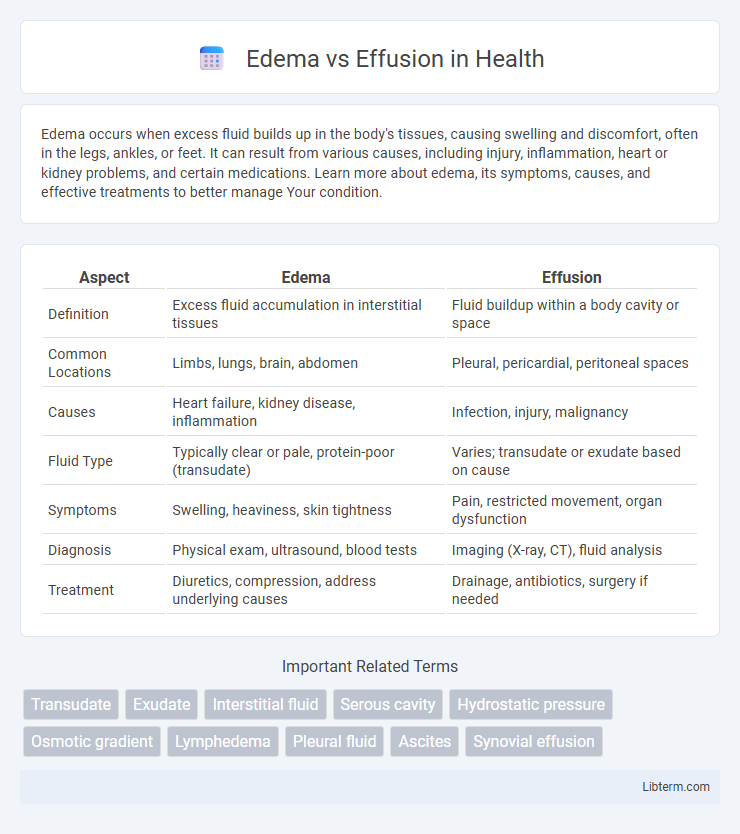Edema occurs when excess fluid builds up in the body's tissues, causing swelling and discomfort, often in the legs, ankles, or feet. It can result from various causes, including injury, inflammation, heart or kidney problems, and certain medications. Learn more about edema, its symptoms, causes, and effective treatments to better manage Your condition.
Table of Comparison
| Aspect | Edema | Effusion |
|---|---|---|
| Definition | Excess fluid accumulation in interstitial tissues | Fluid buildup within a body cavity or space |
| Common Locations | Limbs, lungs, brain, abdomen | Pleural, pericardial, peritoneal spaces |
| Causes | Heart failure, kidney disease, inflammation | Infection, injury, malignancy |
| Fluid Type | Typically clear or pale, protein-poor (transudate) | Varies; transudate or exudate based on cause |
| Symptoms | Swelling, heaviness, skin tightness | Pain, restricted movement, organ dysfunction |
| Diagnosis | Physical exam, ultrasound, blood tests | Imaging (X-ray, CT), fluid analysis |
| Treatment | Diuretics, compression, address underlying causes | Drainage, antibiotics, surgery if needed |
Introduction to Edema and Effusion
Edema refers to the abnormal accumulation of fluid within the interstitial spaces of tissues, often caused by inflammation, injury, or systemic conditions like heart failure. Effusion involves the buildup of fluid in body cavities such as the pleural, pericardial, or synovial spaces, frequently resulting from infections, malignancies, or trauma. Both conditions signify fluid imbalance but differ in their specific locations and underlying pathological mechanisms.
Defining Edema: Causes and Characteristics
Edema is the abnormal accumulation of fluid in the interstitial spaces of tissues, often caused by factors such as increased capillary hydrostatic pressure, decreased oncotic pressure, or lymphatic obstruction. Common causes include heart failure, kidney disease, liver cirrhosis, and localized inflammation or injury, leading to swelling, puffiness, and impaired tissue function. Its characteristics involve visible tissue swelling, pitting on pressure, and may vary in severity depending on the underlying condition and fluid retention levels.
Understanding Effusion: Key Features and Origins
Effusion refers to the abnormal accumulation of fluid within a body cavity, such as the pleural, pericardial, or joint spaces, often resulting from inflammation, infection, or trauma. Unlike edema, which is the swelling caused by fluid buildup in the interstitial tissues, effusion involves fluid specifically confined within anatomical spaces, making it detectable via imaging techniques like ultrasound or X-ray. Identifying the characteristics and origins of effusion is crucial for diagnosing underlying conditions such as pleuritis, pericarditis, or arthritis, guiding appropriate treatment strategies.
Pathophysiological Differences Between Edema and Effusion
Edema involves the abnormal accumulation of fluid within the interstitial tissue spaces due to increased hydrostatic pressure, decreased oncotic pressure, or lymphatic obstruction, reflecting systemic or localized tissue imbalances. Effusion represents the excessive fluid buildup within body cavities such as the pleural, peritoneal, or pericardial spaces, primarily caused by inflammation, infection, malignancy, or injury disrupting the serous membrane integrity. Pathophysiological differences hinge on fluid location--interstitial for edema versus potential spaces lined by mesothelial cells for effusions--and underlying mechanisms involving vascular permeability changes versus lymphatic drainage or pressure alterations.
Common Sites of Edema vs. Effusion
Edema commonly occurs in the lower extremities such as the ankles and feet due to gravity-dependent fluid accumulation, as well as in the lungs (pulmonary edema) and brain (cerebral edema) from localized or systemic causes. Effusions typically accumulate in body cavities including the pleural cavity (pleural effusion), pericardial sac (pericardial effusion), and peritoneal cavity (ascites). Differentiating these sites helps guide diagnostic imaging and targeted treatment strategies.
Clinical Manifestations and Symptoms
Edema presents with localized or generalized swelling due to fluid accumulation in the interstitial tissue, often accompanied by skin tightness, pallor, and discomfort. Effusion is characterized by abnormal fluid buildup within a body cavity such as the pleura, pericardium, or joints, leading to symptoms like restricted mobility, pain, and possible respiratory distress in pleural effusions. Clinical manifestations of effusion depend on the affected site and may include decreased breath sounds, joint stiffness, or chest pain, distinguishing it from the more diffuse swelling seen in edema.
Diagnostic Approaches for Edema and Effusion
Diagnostic approaches for edema involve physical examination, measurement of limb circumference, and imaging techniques such as ultrasound or MRI to assess fluid accumulation and underlying causes. Effusion diagnosis typically relies on joint aspiration (arthrocentesis) followed by fluid analysis, alongside imaging methods like X-rays, ultrasound, or MRI to detect and evaluate fluid in body cavities. Laboratory tests, including blood work and biomarkers, support differentiation between edema and effusion by identifying inflammatory, infectious, or systemic etiologies.
Treatment Options: Edema vs. Effusion
Treatment options for edema primarily include diuretics, compression therapy, and lifestyle modifications such as salt restriction and elevation of the affected limb. Effusion management involves addressing the underlying cause, often requiring aspiration of the fluid, corticosteroid injections, or surgical intervention if infection or chronic inflammation is present. Both conditions may benefit from physical therapy to improve lymphatic drainage and joint mobility.
Prognosis and Complications
Edema, characterized by the accumulation of excess interstitial fluid, often has a favorable prognosis when the underlying cause is addressed, but chronic or severe cases can lead to complications such as skin ulcers or infections. Effusion, the buildup of fluid within body cavities like the pleural or pericardial space, may indicate more serious underlying conditions including infections, malignancies, or heart failure, with prognosis depending on timely diagnosis and treatment of the primary disease. Complications of untreated effusion include impaired organ function, respiratory distress, or cardiac tamponade, highlighting the importance of distinguishing between these fluid accumulation types for effective clinical management.
Conclusion: Distinguishing Edema from Effusion
Edema involves fluid accumulation within the interstitial tissue, while effusion refers to fluid buildup within a body cavity such as the pleural or pericardial space. Accurate differentiation relies on clinical evaluation combined with imaging modalities like ultrasound or CT scans to identify the fluid's anatomical location. Recognizing these distinctions is crucial for diagnosis and guiding appropriate therapeutic interventions.
Edema Infographic

 libterm.com
libterm.com